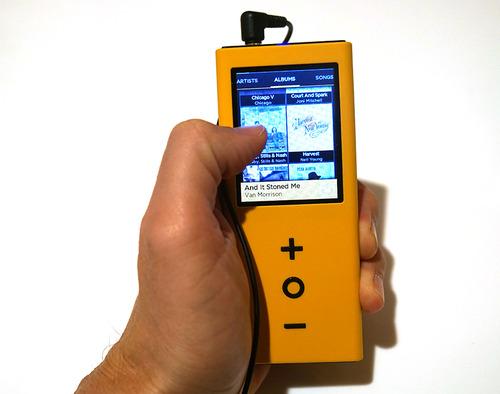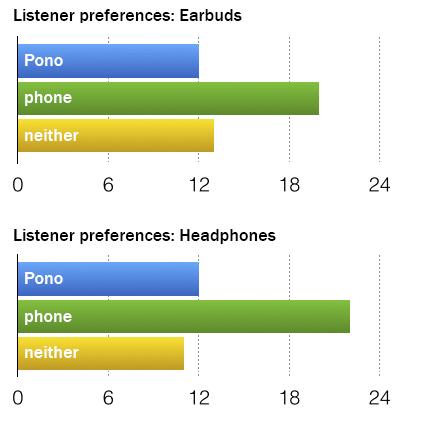

Posted on 02/02/2015 12:29:06 PM PST by Swordmaker
It was one of Kickstarter’s most successful campaigns. Its inventors sought $800,000 in funding from the public — but raised a gigantic $6.2 million.


The project: the PonoPlayer, “a revolution in music listening.” It was designed to play back music files that use up to 20 times more data than the MP3 files that gave the first pocket music players a bad name.
“Everyone who’s ever heard PonoMusic will tell you that the difference is surprising and dramatic,” Pono wrote on Kickstarter. “They tell us that not only do they hear the difference; they feel it in their body, in their soul.”
In Pono’s Kickstarter pitch video, famous musicians react to the Pono sound they’ve just heard. “That music made me feel good. Much better than I’ve felt in a long time listening to music,” says Norah Jones. “This gives it to you as good as you can get it,” says Tom Petty. “MP3 [the old format] is like seeing a Xerox of the Mona Lisa,” says Elvis Costello.
Neil Young, celebrity founder and driving force for Pono, points out that MP3 is a compression scheme. It was developed in the era of music players with limited storage capacity; the idea was to shrink the music files by discarding music data from the original recordings. But these days, storage is copious and cheap. So why are we still compressing our music? Why can’t we listen to our music the way it was recorded in the studio, according to the musician’s original intentions?
The Pono Player, once just a Kickstarter prototype, is now a product that anyone can buy, for $400. To hear the magic, you’re supposed to buy all new music—high-resolution audio files—from Pono’s new music store (ponomusic.force.com), and load them onto your Pono using a new Mac or PC loading-dock program (Pono World). Albums cost about $25 each.
You’ve got to admit it: The argument for the Pono Player sure is appealing — that we don’t know what we’ve been missing in our music.
Unfortunately, it isn’t true.
Remember Neil keeps pushing this primarily to musicians. They can hear the difference between studio recording and CDs. That’s his big push, studio quality, let the audience hear what the artist heard in the booth. And maybe most of us can’t tell the difference, but it’s there. Think back to the glory days of hifi, and that crazy neighbor who had this super amazing equipment that nobody else could really tell the difference on. It’s similar.
One correction comment on the oversampling part...one uses oversampling to provide a means by which the low pass filtering that occurs after the digital to analog conversion to be done with digital filtering and less of an analog “brick wall” filter. When one uses the 44.1 kHz samples, the analog filtering must provide a very steep drop off around 20 kHz in order to avoid spurious “things” appearing in the sound. This so-called “brick wall” filtering introduces phase and amplitude anomalies which some folks feel contribute to digital’s rather steely sound.
This oversampling technique can also be used on the recording side, thereby lessening the effect of the analog to digital filtering. The digitized oversamples can then be “smoothed” digitally in order to reduce to the CD’s 44.1 kHz sample rate.
Sorry for the geektalk, but there is good reason for oversampling.
Nothing in the above (probably boring) set O’paragraphs is meant to disparage or not disparage the PonoPlayer. It’ll succeed or fail based on its design and performance.
I can remember the first CD I ever heard.
It was Heart “How Deep It Goes”. I never heard that range of octaves before in my life. I was amazed.
All my CDs are sampled at 128mhz. And sound Awesome on any device. Use a matchbook sized mp3 to exercise and an ipod for other stuff.
Have the ipod connected to a new digital amp playing through 2 50 y/o Advent big-wooden-cabinet speakers and it blows me away.
All my CDs are sampled at 128mhz.
Methinks you meant 128 ksamples/sec. And I agree that the sound at the rate (given good MP3 algorithms) is not bad at all. The algrorithms do appear to have some problems with very complex music...resulting in the “tizzy” highs we hear from some music.
I truly pity the deaf! Imagine never hearing this right here in my ear......
https://www.youtube.com/watch?v=RwbNSSyQex8
I happen to like Monster Cables, but given the massive difference in cost between Monster's cheapest and most expensive cables, the performance difference in an uncontrolled setting is fractional at best. Most people don't see a value in paying to overcome that difference, especially those on a budget.
This part of the PonoPlayer article makes a similar argument:
Among those who could hear any difference, I asked how much difference there seemed to be. I wanted to see whether this was some astounding, worthwhile improvement or perhaps partly imagination. On average, my participants said that when they heard a difference at all, it was about 10 percent. Fourteen of my 15 participants said they would not spend $400 for a new player (not to mention buying all new songs) to attain that difference.
Got a matchbook-sized mp3 on amazon for literally $3 and it has a micro SD slot. Clipped to my top while exercising, it’s perfect.
I’m trying to figure out why I just wasted one minute watching that before I decided yes, it definitely is torture.
Don’t forget that because the music has been remastered that they will also get to get a new copyright for that music which means royalties for another 75 years.
I think there are far more people who want to believe they can hear the difference than people who actually CAN hear the difference. Listen to the way some of these “audiophiles” describe the supposed difference in sound quality and they seem to be making up terms, none of which have any actual definable meaning related to music.
“You know the $40 wine is better because the “experts” say so, but your nose and taste buds are just fine with the $20 bottle.”
I agree, I have known those who rant on and on about their discerning taste for fine Scotch. I know of one case where one of those guys took his own bottle to a party and after the first drink someone poured his expensive scotch into another bottle and filled his bottle with the cheapest “rotgut” and he never even suspected it. He kept mixing drinks until he was quite well lubricated and never noticed the difference. As for wine my favorite is probably the cheapest wine I have ever tasted, it is about the only one I really like other than champagne, I do like champagne but I can’t even afford the cheap stuff.
This player is superior to most other players because of the DAC it uses. The vast majority of people will never notice the difference, not sure if it is because they do not have sensitive ears or just don't give a sh@@.
The other thing about this player is it can hold 2x more than any ipod that you can buy out there since the ipod classic was discontinued. Once again, most people do not care about this. I do, because I do not want to choose what music I take with me— I want all of it.
I do not have one of these, but it was in the running when I was replacing my Ipod.
In the early days people were saying the CD sounded amazingly superior to vinyl albums, now they tell us the vinyl actually has the better sound because analog is more natural than digital recording. The more things change the more they stay the same. Same thing with the convesion from vacuum tube amps to transistor amps, it was the greatest thing on Earth for a while but when vacuum tubes almost disappeared suddenly there was a purist type appearing who said that transistors had a “grainy” sound etc. etc. and only vacuum tubes were good enough for anyone with a golden ear. I say horsefeathers. I would love to own a Model “A” Ford in great condition but I would certainly not choose it for a coast to coast trip.
The majority of the value of the cable is in the last inch on each end. How good is the tip, how much will it oxidize and how well does it connect to the wire? Other than that you just need a wire with a wide enough gauge and flexible enough to not break.
I had an electronic hobbyist magazine which tested various cable's frequency characteristics from multi-hundred dollar "beastie" cables (as they called them to avoid law suits) to 24 gauge Radio Shack wire down to Romex house wiring cable. The Romex dropped about 3 dB at 20kHz, but other than that the cables were about the same.

Neil and tech: Not exactly a match made in heaven.
NEIL is living in a rather curious and apparently boring time warp of some sort.
His body appears to be present in the 21st century while his mind has remained in the middle 1960’s.
To do that you would have to put your "low-res" music on it... and make Neil Young cry. :-)
And to think of the compression I used to squeeze two albums on my Rio 500 with 64MB.
I applaud his attempt to remaster older music. . . but to attempt to sell his Klunky kludge of a music player by demonstrating it by comparing it to the worst of the file formats as though they are representative of the state of the art is tantamount to fraud.
When listening to a mix of Pono and iPhones and Pono and iTunes purchased on good headphones or Apple earbuds, these are the results of a blind test on listeners. . . who had no idea which they were listening to of either music player or source of the music on either earphones or earbuds.

For those who made a choice (discounting those who couldn't discern a difference) two-thirds to three-quarters preferred the iPhone's playback. . . and it made no difference where the music came from. They could discern no difference between Pono music and iTunes.
Disclaimer: Opinions posted on Free Republic are those of the individual posters and do not necessarily represent the opinion of Free Republic or its management. All materials posted herein are protected by copyright law and the exemption for fair use of copyrighted works.